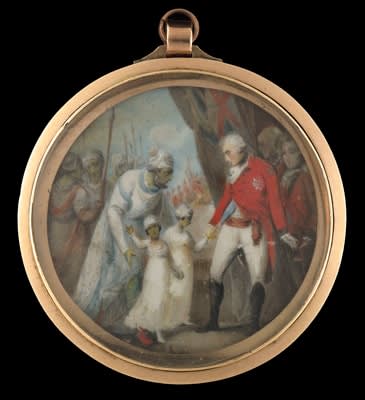
English School
Lieutenant-General Lord Cornwallis (1738-1805), receiving as hostages two sons of Tipu Sultan at the end of the Third Anglo-Mysore war in 1792, Late 18th Century
Watercolour on ivory
Circular, 1 13/16 in. (46mm) diam.
Philip Mould & Co.
To view all current artworks for sale visit philipmould.com Gold Plated Frame, the reverse glazed to reveal red silk This portrait miniature was probably painted by the British...
To view all current artworks for sale visit philipmould.com
This portrait miniature was probably painted by the British portrait miniaturists for a British client to commemorate this significant event in both the Mysore War and the long distinguished career of Lord Cornwallis. The event caught the imagination of both public and artists alike and was most famously recorded in oil by Robert Home (1752-1834) (now in the National Galleries of Scotland, with another version in the National Army Museum). Other versions were made by less well known artists, such as the American Mather Brown )1761-1831), whose 1792 version, in watercolour on Ivory, has all the hallmarks of an English hand, although the faces are too small to suggest a singular artist.
The vignette is closest to the version of events as painted by Henry Singleton in 1793 (sold Sothebys 23 November 1977). Here the turbans and dress of the two princes are similar (unlike the red turbans shown in Home’s version).
'Lord Cornwallis, attended by his staff, and some of the principal officers of the army, met the Princes at the door of his large tent as they dismounted from the elephants; and, after embracing them, led them in, one in each hand, to the tent; the eldest, Abdul Kalick, was about ten, the youngest, Mooza-ud-Deen, about eight years of age. When they were seated on each side of Lord Cornwallis, Gullam Ally, the head vakeel, address his Lordship as follows. "These children were this morning the sons of the Sultan my master; their siutation is now changed, and they must look up to your Lordship as their father.'During the Third Mysore War (1790–1792), a British force underLt.-General Lord Cornwallis (1738–1805), Governor-General of India, besieged Tipu Sultan, ruler of Mysore, in his fortified island capital of Seringapatam. Tipu eventually made peace by ceding a large part of his dominions and a substantial financial settlement to the British. However, Cornwallis also demanded two of Tipu’s sons as hostages to ensure that the Treaty was fulfilled.
The young Princes Abdul Khaliq (aged 10) and Mohin-ud-din (aged eight), left their father’s city in some state, mounted on elephants in a procession led by camels and standard bearers, followed by an escort guard. They were received by Cornwallis with a 21-gun salute, and were each presented with a gold watch. In return, they gave him a fine Persian sword. In March 1794, on the fulfilment of his promises, the hostages were returned to their father.
Gold Plated Frame, the reverse glazed to reveal red silkThis portrait miniature was probably painted by the British portrait miniaturists for a British client to commemorate this significant event in both the Mysore War and the long distinguished career of Lord Cornwallis. The event caught the imagination of both public and artists alike and was most famously recorded in oil by Robert Home (1752-1834) (now in the National Galleries of Scotland, with another version in the National Army Museum). Other versions were made by less well known artists, such as the American Mather Brown )1761-1831), whose 1792 version, in watercolour on Ivory, has all the hallmarks of an English hand, although the faces are too small to suggest a singular artist.
The vignette is closest to the version of events as painted by Henry Singleton in 1793 (sold Sothebys 23 November 1977). Here the turbans and dress of the two princes are similar (unlike the red turbans shown in Home’s version).
Major Dirom's 'A narrative of the Campaign in India in 1792' provided a vivid description of this scene:'Lord Cornwallis, attended by his staff, and some of the principal officers of the army, met the Princes at the door of his large tent as they dismounted from the elephants; and, after embracing them, led them in, one in each hand, to the tent; the eldest, Abdul Kalick, was about ten, the youngest, Mooza-ud-Deen, about eight years of age. When they were seated on each side of Lord Cornwallis, Gullam Ally, the head vakeel, address his Lordship as follows. "These children were this morning the sons of the Sultan my master; their siutation is now changed, and they must look up to your Lordship as their father.'During the Third Mysore War (1790–1792), a British force underLt.-General Lord Cornwallis (1738–1805), Governor-General of India, besieged Tipu Sultan, ruler of Mysore, in his fortified island capital of Seringapatam. Tipu eventually made peace by ceding a large part of his dominions and a substantial financial settlement to the British. However, Cornwallis also demanded two of Tipu’s sons as hostages to ensure that the Treaty was fulfilled.
The young Princes Abdul Khaliq (aged 10) and Mohin-ud-din (aged eight), left their father’s city in some state, mounted on elephants in a procession led by camels and standard bearers, followed by an escort guard. They were received by Cornwallis with a 21-gun salute, and were each presented with a gold watch. In return, they gave him a fine Persian sword. In March 1794, on the fulfilment of his promises, the hostages were returned to their father.
Be the first to hear about our available artworks
* denotes required fields
We will process the personal data you have supplied in accordance with our privacy policy (available on request). You can unsubscribe or change your preferences at any time by clicking the link in our emails.